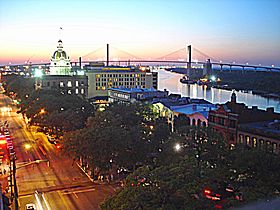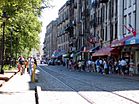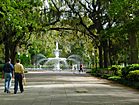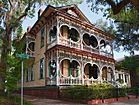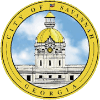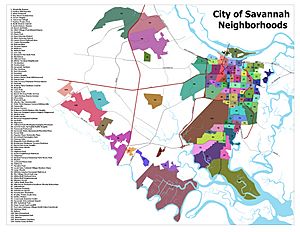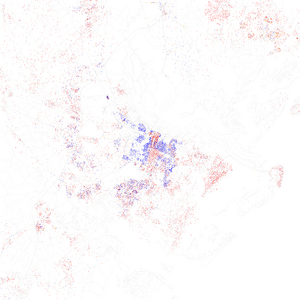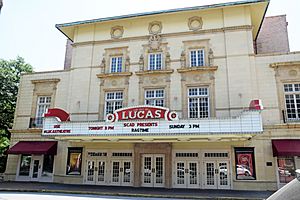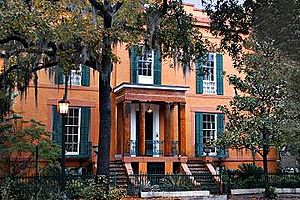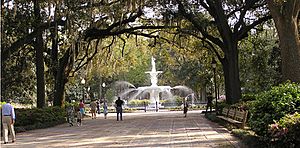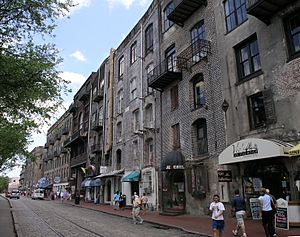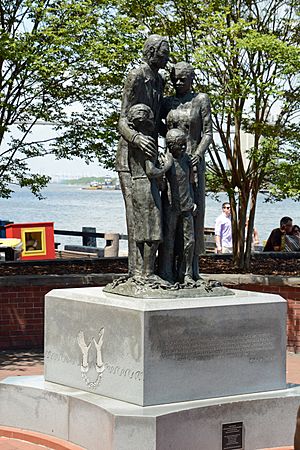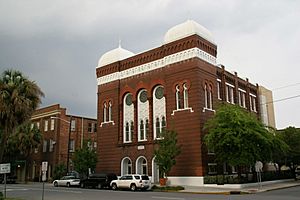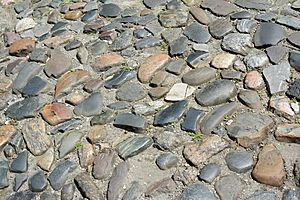Savannah, Georgia facts for kids
Quick facts for kids
Savannah, Georgia
|
|||
|---|---|---|---|
| City of Savannah | |||
|
Clockwise from top: Downtown Savannah viewed from Bay Street, Forsyth Park, historic Gingerbread House in Savannah's Victorian Historic District, Congregation Mickve Israel, and River Street
|
|||
|
|||
| Nickname(s):
"The Hostess City of the South"
|
|||
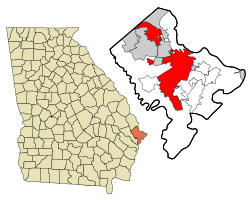
Location within Chatham County
|
|||
| Country | United States | ||
| State | Georgia | ||
| County | Chatham | ||
| Established | February 12, 1733 | ||
| Founded by | James Oglethorpe | ||
| Area | |||
| • City | 113.27 sq mi (293.36 km2) | ||
| • Land | 108.50 sq mi (281.01 km2) | ||
| • Water | 4.77 sq mi (12.35 km2) | ||
| Elevation | 49 ft (15 m) | ||
| Population
(2020)
|
|||
| • City | 147,780 | ||
| • Rank | 185th in the United States 5th in Georgia |
||
| • Density | 1,362.03/sq mi (525.88/km2) | ||
| • Metro | 404,798 (135th) | ||
| Demonym(s) | Savannahian | ||
| Time zone | UTC−5 (EST) | ||
| • Summer (DST) | UTC−4 (EDT) | ||
| ZIP Codes |
31401–31499
|
||
| Area code(s) | 912 | ||
| FIPS code | 13-69000 | ||
| GNIS feature ID | 0322590 | ||
| Website | www.savannahga.gov | ||
Savannah ( sə-VAN-ə) is the oldest city in the U.S. state of Georgia and is the county seat of Chatham County. Established in 1733 on the Savannah River, the city of Savannah became the British colonial capital of the Province of Georgia and later the first state capital of Georgia. A strategic port city in the American Revolution and during the American Civil War, Savannah is today an industrial center and an important Atlantic seaport. It is Georgia's fifth-largest city, with a 2020 U.S. Census population of 147,780. The Savannah metropolitan area, Georgia's third-largest, had a 2020 population of 404,798.
Each year Savannah attracts millions of visitors to its cobblestone streets, parks, and notable historic buildings. These buildings include the birthplace of Juliette Gordon Low (founder of the Girl Scouts of the USA), the Georgia Historical Society (the oldest continually operating historical society in the South), the Telfair Academy of Arts and Sciences (one of the South's first public museums), the First African Baptist Church (one of the oldest African-American Baptist congregations in the United States), Temple Mickve Israel (the third-oldest synagogue in the U.S.), and the Central of Georgia Railway roundhouse complex (the oldest standing antebellum rail facility in the U.S.).
Savannah's downtown area, which includes the Savannah Historic District, its 22 parklike squares, and the Savannah Victorian Historic District, is one of the largest National Historic Landmark Districts in the United States (designated by the U.S. government in 1966). Downtown Savannah largely retains the original town plan prescribed by founder James Oglethorpe (a design now known as the Oglethorpe Plan).
Savannah was the host city for the sailing competitions during the 1996 Summer Olympics held in Atlanta.
History
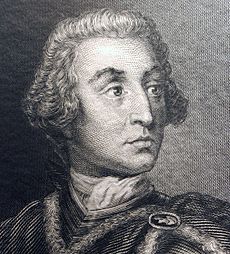
On February 12, 1733, General James Oglethorpe and settlers from the ship Anne landed at Yamacraw Bluff and were greeted by Tomochichi, the Yamacraws, and Indian traders John and Mary Musgrove. Mary Musgrove often served as an interpreter. The city of Savannah was founded on that date, along with the colony of Georgia. In 1751, Savannah and the rest of Georgia became a Royal Colony and Savannah was made the colonial capital of Georgia. By the outbreak of the American Revolutionary War, Savannah had become the southernmost commercial port of the Thirteen Colonies. British troops took the city in 1778, and the following year a combined force of American and French soldiers failed to rout the British at the Siege of Savannah. The British did not leave the city until July 1782. Savannah, a prosperous seaport throughout the nineteenth century, was the Confederacy's sixth most populous city and the prime objective of General William T. Sherman's March to the Sea. Early on December 21, 1864, local authorities negotiated a peaceful surrender to save Savannah from destruction, and Union troops marched into the city at dawn.
Savannah was named for the Savannah River, which probably derives from variant names for the Shawnee, a Native American people who migrated to the river in the 1680s. The Shawnee destroyed another Native people, the Westo, and occupied their lands at the head of the Savannah River's navigation on the fall line, near present-day Augusta. These Shawnee, whose Native name was Ša·wano·ki (literally, "southerners"), were known by several local variants, including Shawano, Savano, Savana and Savannah. Another theory is that the name Savannah refers to the extensive marshlands surrounding the river for miles inland, and is derived from the English term "savanna", a kind of tropical grassland, which was borrowed by the English from Spanish sabana and used in the Southern Colonies. (The Spanish word comes from the Taino word zabana.) Still other theories suggest that the name Savannah originates from Algonquian terms meaning not only "southerners" but perhaps "salt".
Geography
Savannah lies on the Savannah River, approximately 20 mi (32 km) upriver from the Atlantic Ocean. According to the United States Census Bureau (2011), the city has a total area of 108.7 square miles (281.5 km2), of which 103.1 square miles (267.0 km2) is land and 5.6 square miles (15 km2) is water (5.15%). Savannah is the primary port on the Savannah River and the largest port in the state of Georgia. It is also located near the U.S. Intracoastal Waterway. Georgia's Ogeechee River flows toward the Atlantic Ocean some 16 miles (26 km) south of downtown Savannah.
Savannah is prone to flooding. Five canals and several pumping stations have been built to help reduce the effects: Fell Street Canal, Pipe Makers Canal, Kayton Canal, Springfield Canal and Casey Canal, the first four draining north into the Savannah River and the last, the Casey, draining south into the Vernon River.
Climate
Savannah's climate is classified as humid subtropical (Köppen Cfa). In the Deep South, this is characterized by long and almost tropical summers and short, mild winters. Savannah records few days of freezing temperatures each year (and has rare snowfall). Due to its proximity to the Atlantic coast, Savannah rarely experiences temperatures as extreme as those in Georgia's interior. Nevertheless, the extreme temperatures have officially ranged from 105 °F (41 °C), on July 20, 1986, down to 3 °F (−16 °C), on January 21, 1985.
Seasonally, Savannah tends to have hot and humid summers with frequent (but brief) thunderstorms that develop in the warm and tropical air masses, which are common. Although summers in Savannah are frequently sunny, half of Savannah's annual precipitation falls during the months of June through September. Average dewpoints in summer range from 67.8 °F (20 °C) to 71.6 °F (22 °C). Winters in Savannah are mild and sunny with average daily high temperatures close to 60 °F (16 °C). November and December are the driest months recorded at Savannah–Hilton Head International Airport. Each year, Savannah reports 24 days on average with low temperatures below freezing, though in some years less than 10 nights will fall below freezing. Although decades might pass between snowfall events, Savannah has experienced snow on rare occasions, most notably in December 1989, when up to 3.9 inches were recorded in one day in parts of the city.
Savannah is at risk for hurricanes, particularly of the Cape Verde type. Because of its location in the Georgia Bight (the arc of the Atlantic coastline in Georgia and northern Florida) as well as the tendency for hurricanes to re-curve up the coast, Savannah has a lower risk of hurricanes than some other coastal cities such as Charleston, South Carolina. Savannah was seldom affected by hurricanes during the 20th century, with one exception being Hurricane David in 1979. However, the historical record shows that the city was frequently affected during the second half of the 19th century. The most prominent of these storms was the 1893 Sea Islands hurricane, which killed at least 2,000 people. (This estimate may be low, as deaths among the many impoverished rural African-Americans living on Georgia's barrier islands may not have been reported.)
| Climate data for Savannah, Georgia (Savannah/Hilton Head Int'l), 1981–2010 normals, extremes 1871–present | |||||||||||||
|---|---|---|---|---|---|---|---|---|---|---|---|---|---|
| Month | Jan | Feb | Mar | Apr | May | Jun | Jul | Aug | Sep | Oct | Nov | Dec | Year |
| Record high °F (°C) | 84 (29) |
86 (30) |
94 (34) |
95 (35) |
101 (38) |
104 (40) |
105 (41) |
104 (40) |
102 (39) |
97 (36) |
89 (32) |
83 (28) |
105 (41) |
| Mean maximum °F (°C) | 76.3 (24.6) |
79.6 (26.4) |
84.3 (29.1) |
89.4 (31.9) |
93.6 (34.2) |
98.0 (36.7) |
99.3 (37.4) |
97.6 (36.4) |
94.0 (34.4) |
88.6 (31.4) |
82.8 (28.2) |
77.6 (25.3) |
100.3 (37.9) |
| Average high °F (°C) | 60.4 (15.8) |
64.3 (17.9) |
70.9 (21.6) |
77.6 (25.3) |
84.6 (29.2) |
89.9 (32.2) |
92.4 (33.6) |
90.6 (32.6) |
86.0 (30.0) |
78.4 (25.8) |
70.6 (21.4) |
62.5 (16.9) |
77.4 (25.2) |
| Average low °F (°C) | 38.6 (3.7) |
41.7 (5.4) |
47.6 (8.7) |
53.6 (12.0) |
62.1 (16.7) |
69.8 (21.0) |
72.8 (22.7) |
72.4 (22.4) |
67.8 (19.9) |
57.5 (14.2) |
47.9 (8.8) |
40.8 (4.9) |
56.1 (13.4) |
| Mean minimum °F (°C) | 21.7 (−5.7) |
25.9 (−3.4) |
30.8 (−0.7) |
38.3 (3.5) |
49.3 (9.6) |
61.8 (16.6) |
67.8 (19.9) |
66.4 (19.1) |
55.4 (13.0) |
40.9 (4.9) |
32.0 (0.0) |
24.5 (−4.2) |
19.3 (−7.1) |
| Record low °F (°C) | 3 (−16) |
8 (−13) |
20 (−7) |
28 (−2) |
39 (4) |
49 (9) |
61 (16) |
57 (14) |
43 (6) |
28 (−2) |
15 (−9) |
9 (−13) |
3 (−16) |
| Average precipitation inches (mm) | 3.69 (94) |
2.79 (71) |
3.73 (95) |
3.07 (78) |
2.98 (76) |
5.95 (151) |
5.60 (142) |
6.56 (167) |
4.58 (116) |
3.69 (94) |
2.37 (60) |
2.95 (75) |
47.96 (1,218) |
| Average precipitation days (≥ 0.01 in) | 9.0 | 8.1 | 7.7 | 6.8 | 7.0 | 11.9 | 12.3 | 13.5 | 9.6 | 7.1 | 6.8 | 8.4 | 108.2 |
| Average relative humidity (%) | 69.6 | 67.0 | 66.8 | 65.4 | 70.1 | 73.6 | 76.0 | 78.6 | 77.7 | 72.9 | 72.3 | 70.8 | 71.7 |
| Mean monthly sunshine hours | 175.5 | 181.0 | 232.0 | 275.6 | 288.9 | 276.0 | 271.3 | 245.8 | 214.3 | 228.6 | 193.5 | 174.2 | 2,756.7 |
| Percent possible sunshine | 55 | 59 | 62 | 71 | 67 | 65 | 62 | 60 | 58 | 65 | 61 | 56 | 62 |
| Source: NOAA (relative humidity and sun 1961–1990) | |||||||||||||
The first meteorological observations in Savannah probably occurred at Oglethorpe Barracks circa 1827, continuing intermittently until 1850 and resuming in 1866. The Signal Service began observations in 1874, and the National Weather Service has kept records of most data continually since then; since 1948, Savannah-Hilton Head International Airport has served as Savannah's official meteorological station. Annual records (dating back to 1950) from the airport's weather station are available on the web.
Urban
Neighborhoods
Savannah is a city of diverse neighborhoods. More than 100 distinct neighborhoods can be identified in six principal areas of the city: Downtown (Landmark Historic District and Victorian District), Midtown, Southside, Eastside, Westside, and Southwest/West Chatham (recently annexed suburban neighborhoods).
Historic districts
Besides the Savannah Historic District, one of the nation's largest, four other historic districts have been formally demarcated:
- Victorian District
- Cuyler-Brownsville District
- Thomas Square Historic District
- Pin Point Historic District
Demographics
| Historical population | |||
|---|---|---|---|
| Census | Pop. | %± | |
| 1800 | 5,146 | — | |
| 1810 | 5,215 | 1.3% | |
| 1820 | 7,523 | 44.3% | |
| 1830 | 7,303 | −2.9% | |
| 1840 | 11,214 | 53.6% | |
| 1850 | 15,312 | 36.5% | |
| 1860 | 22,292 | 45.6% | |
| 1870 | 28,235 | 26.7% | |
| 1880 | 30,709 | 8.8% | |
| 1890 | 43,189 | 40.6% | |
| 1900 | 54,244 | 25.6% | |
| 1910 | 65,064 | 19.9% | |
| 1920 | 83,252 | 28.0% | |
| 1930 | 85,024 | 2.1% | |
| 1940 | 95,996 | 12.9% | |
| 1950 | 119,638 | 24.6% | |
| 1960 | 149,245 | 24.7% | |
| 1970 | 118,349 | −20.7% | |
| 1980 | 141,654 | 19.7% | |
| 1990 | 137,560 | −2.9% | |
| 2000 | 131,510 | −4.4% | |
| 2010 | 136,286 | 3.6% | |
| 2020 | 147,780 | 8.4% | |
| U.S. Decennial Census | |||
According to the U.S. Census Bureau, Savannah's official 2020 population was 147,780, up from the official 2010 count of 136,286 residents. The Census Bureau's official 2020 population of the Savannah metropolitan area—defined by the Census Bureau as Bryan, Chatham, and Effingham counties—was 404,798, up 16.45% from the 2010 Census population of 347,611. Savannah is also the largest principal city of the Savannah–Hinesville–Statesboro–Jesup Combined Statistical Area, a larger trading area that includes the Savannah and Hinesville Metropolitan Statistical Areas as well as the Statesboro and Jesup Micropolitan Statistical Areas. The official 2020 population of this area was 597,465, up from 525,844 at the 2010 Census.
2020 census
| Race | Num. | Perc. |
|---|---|---|
| White (non-Hispanic) | 54,082 | 36.6% |
| Black or African American (non-Hispanic) | 71,845 | 48.62% |
| Native American | 311 | 0.21% |
| Asian | 5,610 | 3.8% |
| Pacific Islander | 238 | 0.16% |
| Other/Mixed | 5,905 | 4.0% |
| Hispanic or Latino | 9,789 | 6.62% |
As of the 2020 United States census, there were 147,780 people, 53,371 households, and 29,496 families residing in the city.
2010 census
In the official 2010 census of Savannah, there were 136,286 people, 52,615 households, and 31,390 families residing in the city. The population density was 1,759.5 people per square mile (679.4/km2). There were 57,437 housing units at an average density of 768.5 per square mile (296.7/km2). The racial makeup of the city was 55.04% Black, 38.03% White, 2.00% Asian, 0.03% Native American, 0.01% Pacific Islander, 0.93% from other races, and 2.01% from two or more races. Hispanic or Latino of any race were 4.07% of the population. Non-Hispanic Whites were 32.6% of the population in 2010, compared to 46.2% in 1990.
There were 51,375 households, out of which 28.5% had children under the age of 18 living with them, 35.2% were married couples living together, 21.7% had a female householder with no husband present, and 38.9% were non-families. 31.4% of all households were made up of individuals, and 11.5% had someone living alone who was 65 years of age or older. The average household size was 2.45 and the average family size was 3.13.
In the city, the age distribution was as follows: 25.6% were under the age of 18, 13.2% from 18 to 24, 28.5% from 25 to 44, 19.5% from 45 to 64, and 13.3% who were 65 years of age or older. The median age was 32 years. For every 100 females, there were 89.3 males. For every 100 females age 18 and over, there were 84.6 males.
The median income for a household in the city was $29,038, and the median income for a family was $36,410. Males had a median income of $28,545 versus $22,309 for females. The per capita income for the city was $16,921. About 17.7% of families and 21.8% of the population were below the poverty line, including 31.4% of those under age 18 and 15.1% of those age 65 or over.
Arts and culture
Beyond its architectural significance as being the nation's largest, historically restored urban area, the city of Savannah has a rich and growing performing arts scene, offering cultural events throughout the year.
Books and literature
- The Savannah Book Festival – an annual book fair held on Presidents' Day weekend in the vicinity of historic Telfair and Wright squares, includes free presentations by more than 35 contemporary authors. Special events with featured writers are offered at nominal cost throughout the year.
- Flannery O'Connor Childhood Home – a museum house dedicated to the work and life of the acclaimed fiction writer Flannery O'Connor, who was born in Savannah. In addition to its museum, the house offers literary programming, including the annual Ursrey Lecture honoring American fiction writers.
Dance
Savannah Ballet Theatre – established in 1998 as a nonprofit organization, it has grown to become the city's largest dance company.
Music
- The Coastal Jazz Association – presents a variety of jazz performances throughout the year in addition to hosting the annual Savannah Jazz Festival.
- Savannah Children's Choir – non-profit, auditioned choir for children in 2nd through 8th grades that performs throughout the community and in annual holiday and spring concerts.
- Savannah Concert Association – presents a variety of guest artists for chamber music performances each season. Performances are generally held in the Lucas Theatre For The Arts.
- Savannah Music Festival – an annual music festival of diverse artists which is Georgia's largest musical arts festival and is nationally recognized as one of the best music festivals in the world.
- The Savannah Orchestra – Savannah's professional orchestra, which presents an annual season of classical and popular concert performances.
- The Savannah Philharmonic – professional orchestral and choral organization presenting year round concerts (classical, pops, education).
- The Savannah Winds – amateur concert band hosted by the music department of Armstrong State University.
- The Armstrong Youth Orchestra – Savannah's professional orchestra for elementary, middle school, high school and some college students.
Theater and performance
- Muse Arts Warehouse – founded in 2010, Muse Arts Warehouse is a nonprofit organization committed to community-building through the arts by providing a venue that is available, affordable, and accessible to Savannah's individual artists, arts organizations and the public.
- Savannah Children's Theatre – a non-profit, year-round drama theater company geared toward offering elementary through high school students (and adults) opportunities for participation in dramatic and musical productions.
- Savannah Community Theatre – a full theater season with a diverse programming schedule, featuring some of Savannah's finest actors in an intimate, three-quarter-round space.
- Little Theatre of Savannah – founded in 1950, The Little Theatre of Savannah, Inc., is a nonprofit, volunteer-based community organization dedicated to the celebration of the theater arts. Recognizing the unique social value, expressive fulfillment and opportunity for personal growth that theater provides its participants, the Little Theatre of Savannah invites all members of the community to participate both on- and off-stage.
- The Savannah Theatre – Savannah's only fully professional resident theater, producing music revues with live singers, dancers and the most rockin' band in town. Performances happen year-round, with several different titles and a holiday show.
- Lucas Theatre for the Arts – founded in December 1921, the Lucas Theatre is one of several theaters owned by the Savannah College of Art and Design. It hosts the annual Savannah Film Festival.
- Trustees Theater – once known as the Weis Theater, which opened February 14, 1946, this theater reopened as the Trustees Theater on May 9, 1998, and hosts a variety of performances and concerts sponsored by the Savannah College of Art and Design. SCAD also owns the building.
- Odd Lot Improv – founded in 2010, a family-friendly improv comedy troupe performing weekly shows on Mondays and Fridays.
Visual and community arts
- Art Rise Savannah, Inc. – a local community nonprofit devoted to increasing access to the arts and improving opportunities for artists in the city.
Points of interest

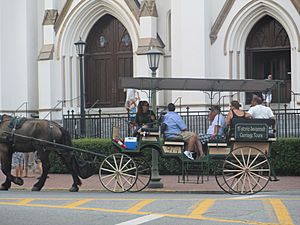
Savannah's architecture, history, and reputation for Southern charm and hospitality are internationally known. The city's former promotional name was "Hostess City of the South," a phrase still used by the city government. An earlier nickname was "the Forest City", in reference to the large population and species of oak trees that flourish in the Savannah area. These trees were especially valuable in shipbuilding during the 19th century. In 2014, Savannah attracted 13.5 million visitors from across the country and around the world. Savannah's downtown area is one of the largest National Historic Landmark Districts in the United States.
The city's location offers visitors access to the coastal islands and the Savannah Riverfront, both popular tourist destinations. Tybee Island, formerly known as "Savannah Beach", is the site of the Tybee Island Light Station, the first lighthouse on the southern Atlantic coast. Other picturesque towns adjacent to Savannah include the shrimping village of Thunderbolt and three residential areas that began as summer resort communities for Savannahians: Beaulieu, Vernonburg, and the Isle of Hope.
The Savannah International Trade & Convention Center is located on Hutchinson Island, across from downtown Savannah and surrounded by the Savannah River. The Belles Ferry connects the island with the mainland, as does the Eugene Talmadge Memorial Bridge.
The Savannah Civic Center on Montgomery Street is host to more than nine hundred events each year.
Savannah has consistently been named one of "America's Favorite Cities" by Travel + Leisure. In 2012, the magazine rated Savannah highest in "Quality of Life and Visitor Experience." Savannah was also ranked first for "Public Parks and Outdoor Access," visiting in the Fall, and as a romantic escape. Savannah was also named as America's second-best city for "Cool Buildings and Architecture," behind only Chicago.
Squares
Savannah's historic district has 22 squares (Ellis Square, demolished in 1954, was fully restored in early 2010). The squares vary in size and character, from the formal fountain and monuments of the largest, Johnson, to the playgrounds of the smallest, Crawford. Elbert, Ellis, and Liberty Squares are classified as the three "lost squares," destroyed in the course of urban development during the 1950s. Elbert and Liberty Squares were paved over to make way for a realignment of U.S. highway 17, while Ellis Square was demolished to build the City Market parking garage. The city restored Ellis Square after razing the City Market parking garage. The garage has been rebuilt as an underground facility, the Whitaker Street Parking Garage, and it opened in January 2009. The newly restored Ellis Square opened in March 2010. Separate efforts are now under way to revive Elbert and Liberty Squares.
Historic churches and synagogues
Savannah has numerous historic houses of worship.
Founded in 1733, with the establishment of the Georgia colony, Christ Church (Episcopal) is the longest continuous Christian congregation in Georgia. Early rectors include the Methodist evangelists John Wesley and George Whitefield. Located on the original site on Johnson Square, Christ Church continues as an active congregation.
The Independent Presbyterian Church (Savannah, Georgia), which was founded in 1755, is located near Chippewa Square. The church's current sanctuary (its third) dates from the early 1890s.
The First Bryan Baptist Church is an African-American church that was organized by Andrew Bryan in 1788. The site was purchased in 1793 by Bryan, a former slave who had also purchased his freedom. The first structure was erected there in 1794. By 1800, the congregation was large enough to split: those at Bryan Street took the name of First African Baptist Church, and Second and Third African Baptist churches were also established. The current sanctuary of First Bryan Baptist Church was constructed in 1873.
In 1832, a controversy over doctrine caused the First African Baptist congregation at Bryan Street to split. Some members left, taking with them the name of First African Baptist Church. In 1859, the members of this new congregation (most of whom were slaves) built their current church building on Franklin Square.
In 1874, the St. Benedict the Moor Church was founded in Savannah, the first African-American Catholic church in Georgia, and one of the oldest in the Southeast.
The oldest standing house of worship is First Baptist Church, Savannah (1833), located on Chippewa Square. Other historic houses of worship in Savannah include: Cathedral of St. John the Baptist (Roman Catholic), Temple Mickve Israel (the third oldest synagogue in the U.S.), and St. John's Church (Episcopal).
Historic homes
Among the historic homes that have been preserved are: the Pink House, the Sorrel-Weed House, Juliette Gordon Low's birthplace, the Davenport House Museum, the Green-Meldrim House, the Owens-Thomas House, the William Scarbrough House, and the Wormsloe plantation of Noble Jones. The Mercer-Williams House, the former home of Jim Williams, is the main location of Midnight in the Garden of Good and Evil
Historic cemeteries
Colonial Park Cemetery (an early graveyard dating back to the English colony of Georgia), Laurel Grove Cemetery (with the graves of many Confederate soldiers and African American slaves) and Bonaventure Cemetery (a former plantation and the final resting place for some illustrious Savannahians).
Historic forts
Fort Jackson, not associated with Andrew Jackson, one mile east of Savannah's Historic District, was originally built between 1808 and 1812 to protect the city from attack by sea. During the Civil War, it became one of three Confederate forts defending Savannah from Union forces. Fort Pulaski National Monument, located 17 miles (27 km) east of Savannah, preserves the largest fort protecting Savannah during the Civil War. The Union Army attacked Fort Pulaski in 1862, with the aid of a new rifled cannon that effectively rendered brick fortifications obsolete.
- Savannah Historic District and the Savannah Victorian Historic District
- Forsyth Park
- Juliette Gordon Low Historic District
- Central of Georgia Railroad: Savannah Shops and Terminal Facilities and Central of Georgia Depot and Trainshed – a 33.2-acre (134,000 m2) historic district that was listed on the National Register of Historic Places in 1978.
- Riverfront Plaza and Factors' Walk – River Street's restored nineteenth-century cotton warehouses and passageways include shops, bars and restaurants
- City Market – Savannah's restored central market features antiques, souvenirs, small eateries, as well as two large outdoor plazas
- Savannah State University campus and Walter Bernard Hill Hall – The Georgia Historical Commission and the Georgia Department of Natural Resources have recognized both the Savannah State campus and Hill Hall as a part of the Georgia Historical Marker Program. Hill Hall, which was built in 1901, was added to the National Register of Historic Places in 1981.
- Telfair Museum of Art and Telfair Academy of Arts of Sciences – the South's first public art museum.
- Wormsloe Plantation – the partially restored house and grounds of an 18th-century Georgia plantation.
Shopping
Various centers for shopping exist about the city including Abercorn Common, Savannah Historic District, Oglethorpe Mall, Savannah Mall and Abercorn Walk.
Other attractions
- Club One – home of The Lady Chablis and made famous in the book and movie Midnight in the Garden of Good and Evil.
- Coastal Georgia Botanical Gardens – a developing botanical garden located at Bamboo Farm, a former USDA plant-introduction station south of Savannah that began operations in 1919.
- Oatland Island Wildlife Center – located east of Savannah, a facility owned and operated by the Savannah-Chatham County Board of Education and featuring wildlife from surrounding coastal Georgia and South Carolina.
- Ossabaw Island – an environmentally protected and commercially undeveloped barrier island south of Savannah.
- Pinkie Masters Bar – a popular Savannah watering hole and the site of presidential visits and political campaigns. Pinkie Masters was a local political figure and a friend of President Jimmy Carter, who made several visits to the bar and the city.
- Pirates' House – historic restaurant and tavern located in downtown Savannah.
- Saint Patrick's Day Celebrations – Savannah holds annual celebrations in honor of Saint Patrick's Day. The actual parade route changes from year to year but usually travels through the Savannah Historic District and along Bay Street. The Savannah Waterfront Association has an annual celebration on River Street that is reminiscent of Mardi Gras on Bourbon Street in New Orleans.
- Skidaway Island – an affluent suburban community south of Savannah that hosts Skidaway Island State Park, the University of Georgia Aquarium and the Skidaway Institute of Oceanography.
- Tybee Island – popular Atlantic resort town 17 mi (27 km) east of Savannah, with public beaches, a lighthouse, and other attractions.
Sports and recreation
Portions of the East Coast Greenway, a 3,000-mile-long system of trails from Maine to Florida, run through Savannah.
Professional sport teams
| Club | Sport | League | Venue | Championships | Notes |
|---|---|---|---|---|---|
| Savannah Ghost Pirates | Ice hockey | East Coast Hockey League | Enmarket Arena | 0 | 2022– |
| Savannah Braves | Baseball | Southern League | Grayson Stadium | 0 | 1971–1983 |
| Savannah Cardinals | Baseball | South Atlantic League | Grayson Stadium | 2 (1993, 1994) | 1984–1995 |
| Savannah Sand Gnats | Baseball | South Atlantic League | Grayson Stadium | 2 (1996, 2013) | 1996–2015 |
| Savannah Bananas | Baseball | Coastal Plain League | Grayson Stadium | 2 (2016, 2021) | 2016–present |
| Savannah Spirits | Basketball | Continental Basketball Association | Savannah Civic Center | 0 | 1986–1988 |
| Savannah Wildcats | Basketball | Continental Basketball League | Georgia Southern University-Armstrong Campus | 1 (2010) | 2010–present |
| Savannah Storm | Basketball | East Coast Basketball League | Savannah High School | 2014–present | |
| Savannah Steam | American football | American Indoor Football | Tiger Arena | 2015–present |
College teams
| Club | Affiliation | Conference | Venues | Notes |
|---|---|---|---|---|
| Savannah College of Art and Design Bees | NAIA | Florida Sun Conference | SCAD Athletic Complex, Ronald C. Waranch Equestrian Center | |
| Savannah State Tigers | NCAA Division II | Southern Intercollegiate Athletic Conference | Tiger Arena, Ted Wright Stadium |
Sister cities
|
Economy
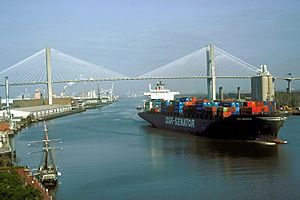
Agriculture was essential to Savannah's economy during its first two centuries. Silk and indigo production, both in demand in England, were early export commodities. By 1767, almost a ton of silk per year was exported to England.
Georgia's mild climate offered perfect conditions for growing cotton, which became the dominant commodity after the American Revolution. Its production under the plantation system and shipment through the Port of Savannah helped the city's European immigrants to achieve wealth and prosperity.
In the nineteenth century, the Port of Savannah became one of the most active in the United States, and Savannahians had the opportunity to consume some of the world's finest goods, imported by foreign merchants. Savannah's port has always been a mainstay of the city's economy. In the early years of the United States, goods produced in the New World had to pass through Atlantic ports such as Savannah's before they could be shipped to England.
Savannah's first hotel, City Hotel, was completed in 1821. It also housed the city's first United States Post Office branch.
Between 1912 and 1968, the Savannah Machine & Foundry Company was a shipbuilder in Savannah.
The Port of Savannah, manufacturing, the military, and tourism have become Savannah's four major economic drivers in the twenty-first century. In 2006, the Savannah Area Convention & Visitors Bureau reported over 6.85 million tourists to the city during the year. By 2011, the Bureau reported that the number of tourists the city attracted increased to 12.1 million. Lodging, dining, entertainment, and tourist-related transportation account for over $2 billion in tourist spending per year and employ over 17,000.
For years, Savannah was the home of Union Camp, which housed the world's largest paper mill. The plant is now owned by International Paper, and it remains one of Savannah's largest employers. Savannah is also home to the Gulfstream Aerospace company, maker of private jets, as well as various other large industrial interests. TitleMax is headquartered in Savannah. Morris Multimedia, a newspaper and television company, is also based in Savannah.
In 2000, JCB, the third-largest producer of construction equipment in the world and the leading manufacturer of backhoes and telescopic handlers, built its North American headquarters in Chatham County near Savannah in Pooler on I-95 near Savannah-Hilton Head International Airport.
Between 2009 and 2017, Savannah was North America's fourth-largest port for shipping container traffic. In 2019, the port continues to see record growth with a reported 4.5 million, 20-foot equivalent container units being moved in the fiscal year.
Education
Savannah hosts four colleges and universities offering bachelor's, master's, and professional or doctoral degree programs: Georgia Southern University-Armstrong Campus, Savannah College of Art and Design (SCAD), Savannah State University, and South University. In addition, Georgia Tech Savannah offers certificate programs, and Georgia Southern University has a satellite campus in the downtown area. Savannah Technical College, a two-year technical institution and the Skidaway Institute of Oceanography, a marine science research institute of the University of Georgia located on the northern end of Skidaway Island, offer educational programs as well. Savannah is also the location of Ralston College, a liberal arts college founded in 2010.
Mercer University began a four-year doctor of medicine program in August 2008 at Memorial University Medical Center. Mercer, with its main campus in Macon, received additional state funding in 2007 to expand its existing partnership with Memorial by establishing a four-year medical school in Savannah (the first in southern Georgia). Third- and fourth-year Mercer students have completed two-year clinical rotations at Memorial since 1996; approximately 100 residents are trained each year in a number of medical practices. The expanded program opened in August 2008 with 30 first-year students.
In 2012, Savannah Law School opened in the historic Candler building on Forsyth Park. The school is fully ABA-accredited and offers full-time as well as part-time programs leading to the juris doctor degree. In early 2018, however, the administration announced that the school would close at the end of the spring semester.
Savannah is also home to most of the schools in the Chatham County school district, the Savannah-Chatham County Public Schools.
Notable secondary schools in Savannah-Chatham County include the following. (Public schools are indicated with an asterisk.)
- Beach High School*
- Benedictine Military School
- Calvary Day School
- Groves High School*
- Islands High School*
- Jenkins High School*
- Johnson High School*
- New Hampstead High School*
- Saint Andrew's School
- St. Vincent's Academy
- Savannah Arts Academy*
- Savannah Christian Preparatory School
- Savannah Country Day School
- Savannah High School*
- Windsor Forest High School*
Oatland Island Wildlife Center of Savannah is also a part of Savannah-Chatham County Public Schools. An environmental education center, it serves thousands of students from schools throughout the Southeastern United States. Located east of Savannah on a marsh island, it features a 2-mile (3.2 km) Native Animal Nature Trail that winds through maritime forest, salt marsh, and freshwater wetlands. Along the trail, visitors can observe native animals, such as Florida panthers, Eastern timber wolves, and alligators in their natural habitat.
Infrastructure
Transportation
Savannah/Hilton Head International Airport is located off Interstate 95 west of Savannah. The airlines serving this airport year-round are Allegiant Air, American Airlines, American Eagle, Delta, Delta Connection, JetBlue, Silver Airways, Southwest Airlines and United Express. Air Canada Express, Frontier Airlines, Sun County Airlines and United Airlines offer seasonal services only.
Amtrak operates a passenger terminal at Savannah for its Palmetto and Silver Service trains, which run between New York City and Miami. (Three southbound and three northbound trains make daily stops at the Savannah terminal).
Public transit throughout the region is assured by Chatham Area Transit (CAT). There are 17 fixed routes, plus the CAT's dot (downtown transportation) system, which provides fare-free bus service on the Forsyth Loop and Downtown Loop, as well as free passage to and from Hutchinson Island via the Savannah Belles Ferry.
Interstates and major highways
 Interstate 95 — Runs north–south just west of the city; provides access to Savannah/Hilton Head International Airport and intersects with Interstate 16, which leads into the city's center.
Interstate 95 — Runs north–south just west of the city; provides access to Savannah/Hilton Head International Airport and intersects with Interstate 16, which leads into the city's center. Interstate 16 — Terminates in downtown Savannah at Liberty and Montgomery streets, and intersects with Interstate 95 and Interstate 516.
Interstate 16 — Terminates in downtown Savannah at Liberty and Montgomery streets, and intersects with Interstate 95 and Interstate 516. Interstate 516 — An urban perimeter highway connecting southside Savannah, at DeRenne Avenue, with the industrialized port area of the city to the north; intersects with the Veterans Parkway and Interstate 16 as well. Also known as Lynes Parkway.
Interstate 516 — An urban perimeter highway connecting southside Savannah, at DeRenne Avenue, with the industrialized port area of the city to the north; intersects with the Veterans Parkway and Interstate 16 as well. Also known as Lynes Parkway. U.S. Route 80 (Victory Drive) — Runs east–west through midtown Savannah and connects the city with the town of Thunderbolt and the islands of Whitemarsh, Talahi, Wilmington and Tybee. Merges with the Islands Expressway and serves as the only means of reaching the Atlantic Ocean by automobile.
U.S. Route 80 (Victory Drive) — Runs east–west through midtown Savannah and connects the city with the town of Thunderbolt and the islands of Whitemarsh, Talahi, Wilmington and Tybee. Merges with the Islands Expressway and serves as the only means of reaching the Atlantic Ocean by automobile. U.S. Route 17 (Ocean Highway) — Runs north–south from Richmond Hill, through southside Savannah, into Garden City, back into west Savannah with a spur onto I-516, then I-16, and finally continuing over the Talmadge Memorial Bridge into South Carolina.
U.S. Route 17 (Ocean Highway) — Runs north–south from Richmond Hill, through southside Savannah, into Garden City, back into west Savannah with a spur onto I-516, then I-16, and finally continuing over the Talmadge Memorial Bridge into South Carolina. State Route 204 (Abercorn Expressway) — An extension of Abercorn Street that begins at 37th Street in midtown (which is its northern point) and terminates at Rio Road and the Forest River at its southern point, and serves as the primary traffic and commercial artery linking downtown, midtown and southside sections of the city.
State Route 204 (Abercorn Expressway) — An extension of Abercorn Street that begins at 37th Street in midtown (which is its northern point) and terminates at Rio Road and the Forest River at its southern point, and serves as the primary traffic and commercial artery linking downtown, midtown and southside sections of the city.- Harry S. Truman Parkway — Runs through eastside Savannah, connecting the east end of downtown with southside neighborhoods. Construction began in 1990 and opened in phases (the last phase, connecting with Abercorn Street, was completed in 2014).
- Veterans Parkway — Links Interstate 516 and southside/midtown Savannah with southside Savannah, and is intended to move traffic quicker from north–south by avoiding high-volume Abercorn Street. Also known as the Southwest Bypass.
- Islands Expressway — An extension of President Street to facilitate traffic moving between downtown Savannah, the barrier islands and the beaches of Tybee Island.
Notable people
Images for kids
-
The German Memorial Fountain in Orleans Square was erected in 1989 to honor the accomplishments of German Americans in Savannah.
See also
 In Spanish: Savannah para niños
In Spanish: Savannah para niños


